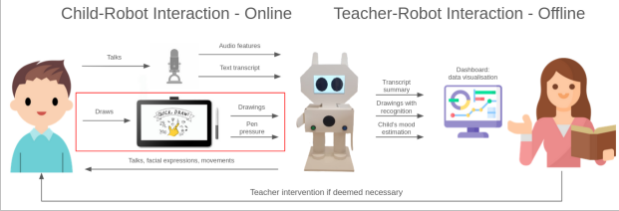Draw My Life: A drawing interface to foster children self-disclosure of personal issues
Bullying is a form of violence that is carried out repeatedly, with the intention of causing harm and with an imbalance of power between those involved [1]. Bullying has serious negative effects on the mental health of adolescents and thus represents a significant health risk in childhood and adolescence [1]. In Germany, around 14% of the children surveyed in the Health Behaviour in School-aged Children (HBSC) study of 2022 reported direct experience of bullying at school [1]. Similarly, in the US in 2021-2022, 19.2% of the surveyed children reported being bullied at school [2]. While bullying is a well-identified problem, a factor limiting the possibility of intervention is the fact that many bullied children remain silent about it. In the US in 2021-2022 for example, only 44.2% of the children who reported being bullied during school notified an adult about the bullying [2]. On the other hand, socially assistive robotics (SAR) is an emerging field aiming at using social robots to assist humans in a variety of applications, including education, hospitality, service or healthcare [3]. In particular, SAR have already been used and shown to be effective in eliciting information disclosure from children about their mental health [4]. Indeed, social robots, by being non-human and non-judgemental, can be seen as a credible and impartial outsider with respect to mankind, thus bringing a novel perspective potentially explaining their success in making children more candid to talk about sensible topics. To this extent, we explore in this research topic the possibility of using social robots as a self-disclosure tool to detect cases of bullying in schools and communicate such cases to the teaching staff, so that appropriate measures can be taken to help silent bullied children.
This specific thesis aims at developing the first block of the robotic system aiming at fostering children self-disclosure of personal issues (Figure 1). More specifically, the activity will be based on the Draw My Life1 concept: the robot will be connected to a Wacom tablet and any child interested in discussing some of their personal issues with the robot will be able to do so by drawing on the tablet what they are narrating. The main goal of this thesis is to develop the drawing interface for the Wacom tablet. In addition, the drawing interface should be able to detect when sub-drawings are finished and convert them into the proper format so that they can be recognized by AI algorithms for drawing recognition. The drawing application will be developed as a ROS2 node.

Figure 1: Description of the robotic system to foster children self-disclosure of personal issues. This thesis focuses on the drawing interface for the Wacom tablet (red rectangle).
Concretely, in this work, you will: (1) review the existing literature on technology used to foster self-disclosure in children , drawing activities for children and AI methods for drawing recognition; (2) develop the drawing interface of the robotic system described above; (3) potentially design a simple experiment with human participants to collect qualitative feedback on the developed drawing interface; (4) summarize the work carried out in a scientific report.
This work requires you to have experience with the Python programming language. Familiarity with ROS, the Pygame library and code versioning (Git/GitLab) can be advantageous.
This work will give you the opportunity to (1) gain experience in Python and ROS programming; (2) learn how to conduct user studies; (3) write and potentially publish a scientific article to a conference in social robotics.
Starting date: April 2025
Supervisor: Romain Maure (romain.maure∂kit.edu)
References:
[1] Fischer, Saskia M., and Ludwig Bilz. "Traditional bullying and cyberbullying at schools in Germany: Results of the HBSC study 2022 and trends from 2009/10 to 2022." Journal of health monitoring 9.1 (2024): 42.
[2] Thomsen, E., et al. "Student Reports of Bullying: Results from the 2022 School Crime Supplement to the National Crime Victimization Survey. Web Tables. NCES 2024-109." National Center for Education Statistics (2024).
[3] Feil-Seifer, David, and Maja J. Mataric. "Defining socially assistive robotics." 9th International Conference on Rehabilitation Robotics, 2005. ICORR 2005.. IEEE, 2005.
[4] Abbasi, Nida Itrat, et al. "Can robots help in the evaluation of mental wellbeing in children? an empirical study." 2022 31st IEEE international conference on robot and human interactive communication (RO-MAN). IEEE, 2022.
.png)